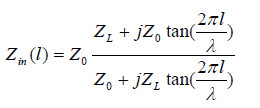how to simulate the effect of 1mm copper for reflection in HFSS?
Can anyone suggest some ways to simulate the effort of a 1mm copper connection with two 100 ohms impedance source at frequency 300MHz. I want to connect two 100 ohms impedance source directly together, but in real PCB, there always have a copper line which is about 1mm. Can anyone suggest ways to simulate the copper line effect using HFSS?
Thanks a lot
you can easily Design Copper line in HFSS with equivalent electrical length correcponding to 1mm using your operating Frequency 300MHz. Define ports of 100Ohms(as you mentioned) at both ends of the Copper line and simulate it in HFSS. you will see the equivalent effect pretty well.
If you have any problem in doing it in HFSS. Do post here aswell,i will help you with it!
/SC
Thanks, so I will see the S11 to see how it affects the matching, right?
Yes Exactly!
HFSS is complete overkill to simulate a short piece of wire.
There are simple equations to calculate the inductance:
Inductance of a Straight Wire: A Calculator
Inductance Calculations: Round Wire over a Ground Plane
Depending on the wire diameter and ground return, you will get something like 0.x nH
For 300MHz application, that series inductance between two 100Ohm ports should not have any visible effect.
Hi
Can I ask why you guys keep talking about inductance? Will the copper line itself serve as a third component which impedance is like a few ohms? Will the input power then be reflected by the dismatch between 2 ohms and 100 ohms? That is what bring up this question.
Moreover, why does HFSS a overkill? Just curious.:)
Thanks a lot
Because this short piece of line will introduce some very small series inductance (and some shunt capacitance, too). If you want to see if that matters, you calculate the inductance value.
Transmission line effects (impedance transformation) can be ignored for this line because line length = 1/1000 wavelength.
If you do the math and caculate the impedance transformation, you will notice that there is no visible effect for this very short line, no matter what the line impedance is.
If the answer can be found in textbooks, there is no need to solve things with a number cruncher.
Actually, for such short lines, the error from simulation setup (port coupling etc). might be bigger than the effect that you are trying to simulate. It just makes no sense.
actually, how long will be a safe guideline for ignore transmission line effect? 1/10 or 1/50 of the wavelength?
thanks
That depends on your requirements. At 1/10 wavelength, I would want to include transmission line effects. At 1/50 wavelength, it should be enough to treat things as lumped elements.
Here is the equation that I was referring to above:

If l << lambda, then Zin=ZL independent of the line impedance Z0
Thanks, it is really helpful.
Hi Guys
I am trying to run the HFSS simulation as an exercise. I did the following:
I create an box from (0,0,0) to (1,1,0.036) with copper materials.
I then need to set up the excitations on the surface (0,0,0)-(0,1,0.036) and surface (1,0,0)-(1,1,0.036). I choosed both lump ports and excitation is at direction (0,0,0) to (0,0,0.036) and same on the second surface.
Finally I draw an cylinder to surround the metal box and run the simulation.
It reports lump errors.
For the same structure I then change the port to waveport for the same setting, they complain about the operation frequency.
Can anyone suggest how to correct set up the excitation for the simulation? ( the simulation is to simulate the 1mm copper with two 100 ohms on both ends, the expected results will be no reflection at 1GHz for such a small wire.
Thank you
---------- Post added at 00:37 ---------- Previous post was at 00:35 ----------
how to set up the excitation there?
It does not work:)
Can you post your file here. I can correct it!
- What is the effect of bodies discretization on the electromagnetic interactions?!
- [ANSYS Electronics Dekstop] Couldn't use eddy effects
- How to remove effect of antenna from measurement result
- Noise effects in a power source in ADS
- Ineffective magnetic core
- Skin effect and proximity effect simulation in Ansys Maxwell
